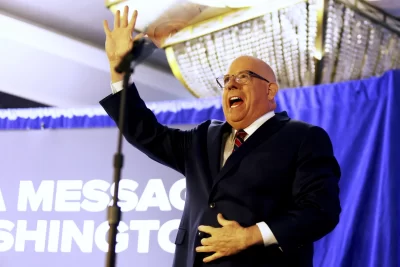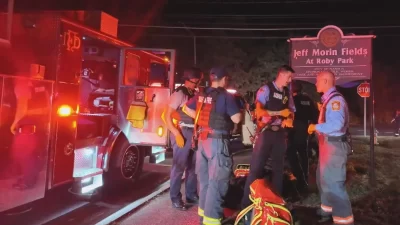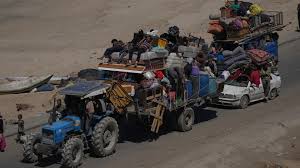
The governor unveiled the plan to state employees on Thursday afternoon, outlining how his administration will deliver on a campaign promise to “leave no one behind.”
“Our state plan is a management tool, but it is also a document that embodies our values. The strategies we deploy will directly affect the lives and livelihoods of Marylanders,” Moore wrote in a letter included in the plan. “This plan is our roadmap of how we will get big things done and restore faith in what government can deliver.”
As mentioned Wednesday in the governor’s State of the State Address, the Moore-Miller administration’s state plan released Thursday afternoon centers on 10 high-level priorities, aspiring to address child poverty, education, the economy, job creation, public safety, housing, infrastructure, health care, clean energy and public service in Maryland.
The administration said its working document was derived from insight developed through the Moore-Miller transition report and accomplishments of their first year, as well as engagement from the community.
“The state plan is really the blueprint for us in the administration and how we are going to govern,” Lt. Gov. Aruna Miller told 11 News on Wednesday. “You really lay it out (to) have measurable ways in which we can (see) whether we are meeting the goals that we established.”
The administration said key performance indicators will track and measure progress as part of a data-driven approach. State officials and the public will be able to track progress on a soon-to-be-launched data dashboard for each state agency.
In response, state Republicans are skeptical. Baltimore County Delegate Kathy Szeliga, R-District 7A, sent a statement to WBALTV.com, saying: “It is certainly long on aspiration and feel-good rhetoric, but short on details and what this is going to cost taxpayers, especially in light of the looming $2.526 billion deficit.”
Ending child poverty
The state plan cites 2021 census data showing one in eight Maryland children lives in poverty, with Baltimore City and Prince George’s County accounting for about 40%.
The state plan outlines efforts to end child poverty through the ENOUGH Act, which calls on poor neighborhoods to come up with plans to lift the community out of poverty in return for state funding.
The governor’s vision streamlines the application and re-enrollment processes for direct-assistance programs, including the Supplemental Nutrition Assistance Program (SNAP) and the Special Supplemental Nutrition Program for Women, Infants, and Children (WIC).
The plan also calls for providing economic benefits assistance to families, from the state and by partnering with nonprofits, through Earned Income and Child Tax credits, nutrition assistance, child care support, health care insurance. The plan also points to supporting small business creation and homeownership in disadvantaged communities.
Education
The plan cites educational inequity that shows gaps between high school graduation rates for Black (10%) and Hispanic (20%) students as compared to their white peers.
“Investing in education is also preparation for Maryland’s competitive and fair future,” the plan states.
The plan cites the governor’s fiscal year 2025 budget proposal that would provide $8.7 billion for K-12 public education — including $900 million for the Blueprint for Maryland’s Future, $422 million for historically Historically Black Colleges and Universities (HBCUs) and $393 million for community colleges.
The plan also cites proposals to expand early childhood education, improve teacher preparation and development programs, promote college and career readiness, strengthening wraparound and mental health services, and hold local education agencies accountable for implementing the Blueprint.
Economy
In 2023, Maryland’s overall economic competitiveness ranked low in the nation, with gross domestic product growth and exports per capita at 49th and 37th in the nation, respectively, according to Maryland Chamber of Commerce data.
According to a study released in January by the state comptroller, Maryland’s economic growth effectively stalled in 2017 and has been stagnant ever since.
The plan cites accomplishment from the administration’s first year in office, during which the Maryland Economic Council was created to drive an economic development strategy. The governor signed bills to direct state funding toward tech-driven infrastructure and renewable energy efforts, as well as the Access to Banking Act, which is intended to improve access for low- and moderate-income communities to work and wealth.
The plan cites Baltimore’s designation as a Tech Hub and the FBI’s relocation to Greenbelt as key drivers to create jobs. The plan calls for developing key business sectors — from life sciences to artificial intelligence to aerospace — as well as making it easier to start and run a business in Maryland and attract federal, private and foreign investments in the state.
Job creation
The plan further noted reporting from the U.S. Chamber of Commerce that categorized Maryland as most severe in the worker shortage index nationally, trailing behind peer states. The plan also cited a worker shortage in the state that worsened during the COVID-19 pandemic.
This plan aims to help workers move to in-demand jobs, such as health care and information technology, and increase labor force participation among women, youth, people with disabilities and justice-involved workers.
Public safety
In his State of the State address, Moore said public safety is a top priority. The state plan cites the governor’s fiscal year 2025 budget proposal as providing $127 million to local law enforcement, as well as efforts to coordinate between local and federal law enforcement agencies.
As part of the plan, key priorities include increasing accountability for the most violent offenders by providing training to resolve cases; offering grants to communities from the Governor’s Offices of Crime Prevention and Policy and Children; and establishing a statewide Center for Firearm Violence Prevention and Intervention to track data and reduce recidivism.
Key performance indictors for these goals include gun-seizure data, as well as homicide and carjacking rates.
Affordable housing
“To the people who said we need to make Maryland more affordable: We hear you,” Moore said in his State of the State address. “In 2022, Maryland was ranked the seventh most expensive state to live in.”
The plan cites a recent Stanford University study that shows affordable housing development revitalizes low-income neighborhoods, increases house prices 6.5%, lowers crime rates and attracts racially and income-diverse populations.
To that end, the plan proposes to build new and preserve existing affordable housing units; revitalize disinvested communities that includes aging commercial corridors; reducing homelessness through voucher programs and housing options; and build wealth through homeownership by expanding financial assistance programs.
Infrastructure
Maryland received a C-ranking by the American Society of Civil Engineers for infrastructure as the decline of public transit ridership continues, the plan states.
In the last year, the governor cited as accomplishments the replacement project for the Frederick Douglass Tunnel; the investment to expand high-speed internet access; and the relaunch of Baltimore’s Red Line east-west transit project.
The plan calls for improving infrastructure safety to minimize traffic deaths and serious injuries; supporting reliable public transit systems with a focus on accessibility; focusing on transit-oriented development to support economic growth; and expanding the state’s infrastructure for electric vehicles and alternative fuels.
Health care
The governor cited investments to improve Maryland’s health systems that include $1.4 billion for mental health and substance abuse disorder services, $12.3 billion for Medicaid and the Children’s Health Program, and $1.9 billion to support community services for developmentally disabled Marylanders.
One of the plan’s objectives focus on improving eligibility and access to quality care, particularly maternal and infant health, behavioral health, and support for veterans and older adults.
The plan would further aim to improve the affordability of care and prescription drugs, as well as eliminate health equity disparities.
Clean energy
According to the plan, Maryland is the fourth most vulnerable state when it comes to sea level rise, which marks an extreme threat as 72% of Marylanders live in coastal areas.
The governor touted releasing some $14.3 million for environmental programs, including the Climate Solutions Now Act, which aims to reduce the state’s greenhouse gas emissions. The governor committed the state to achieve 100% clean energy by 2035.
The plan’s five objectives include decarbonizing and mitigating the effects of climate change; improving water and soil quality; increasing resilience, such as restoring living shorelines and increasing land/forest preservation; promoting a clean economy through green and blue infrastructure projects and jobs; and advancing environmental justice through regulations and outreach.
Public service
Fresh off his inauguration, the governor prioritized making Maryland a state of service by establishing the Maryland Department of Service and Civic Innovation and creating a service year option for youths. The 2024 state plan would further those efforts.







